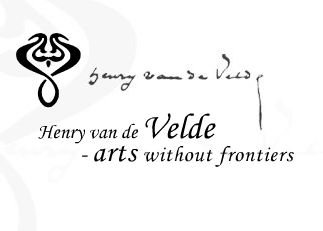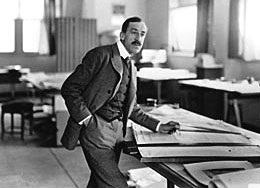Henry van de Velde's design of the interiors of the former sanatorium in Trzebiechów
( research and conservation work )
'We have been destined to live in times in which art has collapsed...,' wrote Henry van de Velde in his general comments on the synthesis of art in 1898. That was surely where the efforts of progressive artists contemporary with him, aimed at presenting the aspects of the new art in all its domains, found their creative source.
Novel ideas were to bind everywhere, from architecture to the tiniest utility items. All that in accordance with the principle of equality of all forms and methods of expression in art - just as it was evident in a variety of van de Velde's works of art, not only buildings and their interiors but also fittings and furnishings therein. 'Otherwise, it would be nothing but a principle of hierarchy taken to extremes, some forms of art brutally elbowing their way to the top and others - perhaps the most vibrant ones - being awkwardly pushed aside.'
Discoveries are often accidental; it is particularly true about coservators of works of art. The year 2004 marked the beginning of renovation work in the main building, during which a fragment of ornamentation was exposed. The Office of the Lubuskie Province Conservator of Monuments in Zielona Góra turned to me with the request to carry out tests for the presence of polichromy in the representative rooms of the main as well as the administrative - housing buildings of the former sanatorium. The overriding objective of the research work was to determine the original colouring design of the interiors, its artistic plan and conception as well as the technique in which particular elements were done. It was the basis on which the guidelines for further renovation and conservation work in the monumental interiors could be laid down1.
Under several layers of paint on the ceilings and walls of the representative rooms there was original polichromy designed by the eminent Belgian. The exposure of the original, its primary colouring design, the pattern of the drawing as well as the discovery of the technique turned out to be a great experience not only for the conservator but, above all, for the researchers studying the creative output of Henry van de Velde. The discovery enabled us to recognize the conception and artistic plan for particular rooms in the sanatorium. Despite its variety, the conception thematically brings all the designed rooms together. It is most extraordinary that despite renovation work that has been carried out a number of times and the numerous layers of overpainting, the polichromy survived and has been preserved in good condition to this day. As you know, most specimens of original polichromy by Henry van de Velde in other places have been destroyed and nearly all of the remaining ones constitute just contemporized replication of the artist's design. Therefore, the painting decorations in Trzebiechów are an original work of art, custom - designed to suit this particular place, preserved not only in their original form but, more importantly, in the original colour and painting technique. Despite several previous studies, specialist meetings and discussions on the Trzebiechów discovery, it was not until the research which confirmed the presence of the polychromy was conducted that the colouring conception of the interiors was shown in a true light. One must not forget about the colouring of detail - the painted windows, custom doors, decorative door casings, stairs and balustrades.
Designing the interiors of the sanatorium, Henry van de Velde subordinated the expression of colour to the painting technique including the character of the surface and the method of paint application, once glossy, then matt, once thinned, then with distinct texture.
The author also decided to make some alterations to the original conception. For example, the artist changed the colouring of the ceiling in one of the so - called social rooms from orange into green and widened the band of the ornamentation running along the walls.
One must remember that an ornament played a very special role in Henry van de Velde's output. According to the artist, it was a symbol. Such is the title - 'Das Ornament als Symbol' - of one of the chapters in his book entitled 'Die renaissance im modernen Kunstgewerbe', published in Berlin in 19012.
'Let us strip the utility items around us off ornaments that are void of meaning, for which there is no reason for existence, and which consequently convey no beauty' wrote Henry van de Velde in the above - mentioned chapter.
When designing the interiors of the sanatorium buildings as well as the fittings and furnishings therein, the artist put into practice his idea postulating that 'we must not allow any divisions in art that would rank some of its various forms and possible expressions higher than others...'3
The discovery of Trzebiechów must be considered especially important for European art as after a hundred years another work of art by an eminent world - class artist, Henry van de Velde, saw the light of day. Most probably, it was the anonymity of the work that ensured its preservation. The fact that the polichromy was painted over, protected it from destruction; also the out - of - the - way location of the buildings caused that the magnificent fittings and door handles have not been stolen and sold as scrap - metal.
Painting decorations in two social rooms, the billiard room and on the walls along the stairs in the main hall have been exposed to date. Also, reconstruction of the unpreserved ceiling decoration in the dining room has been conducted. The conservation work consisted in removing the layers of overpainting, repairing the plasterwork and working its surfaces (so as to achieve texture similar to that of the original plasterwork), as well as carrying out restoration work, such as the repairing of the paintwork and the reconstructing of the missing elements of the patterned stencil decoration. When repairing the layers of paint it was important to preserve the diverse character of the original layers. The ornamentation and some surfaces of the walls and ceilings were done in the fat oil technique on plaster, while other parts of the walls were done in the thin glue technique. Thanks to the restoration efforts the original colouring has been restored to the windows and doors. The interiors were once complete with original details - furniture, flooring, lamps. Being in charge of the reconstruction work and doing it myself, I considered it important that special emphasis be laid on restoring the meaning of detail to these interiors. In the social room the original character of the flooring has been restored - it has been laid with the then fashionable dark brown linoleum. Also, stylish lamps have been installed. In the billiard room the brown and red parquet has been restored. In accordance with the artist's original conception, skirting boards and lamps in the style of the epoch have been fitted. As befits the billiard room, it has been furnished with a billiard table dating back to the epoch.
A separate problem concerning the conservation and restoration work was the reconstruction of the unpreserved polichromy on the ceiling of the dining room, which was entirely destroyed. Therefore, the prime objective of the effort was to make complete reconstruction of it. Thanks to the fact that some black-and-white photographs of the dining room and the painting decoration therein have been preserved, a decision was made to reconstruct the ornamentation in colouring corresponding to that in the other rooms of the sanatorium. The only colour that was considered original was the olive green on the walls of the dining room - tiny fragments of this colour were exposed during the research work. Before undertaking the reconstruction work a number of drawing and colouring designs were produced to determine both the contouring of the form of the ornamentation and the colouring composition. It was of paramount importance to conduct a colour - valued analysis of colours present in the black-and-white photographs. For this purpose, the colouring designs were subject to a processing procedure consisting in removing of the colours and a subsequent analysis of colour - valued contrasts preserved in the photographs. The reconstruction of decorations was carried out by means of stencils. Their size was calculated on the basis of preserved archival photographs of the interiors.
The interiors of the sanatorium in Trzebiechów are absolutely admirable for their colouring, the contouring of the ornamentation and their detail. The decorations along the corridors of the hall in the main building and the dado decorations along the staircase of the administrative building still remain uncovered. The walls and the ceiling also require further renovation effort. The quantity and the high quality of the exposed painting decorations make the Trzebiechów monument of unique meaning to the whole of the world culture.
In the March issue of 'Deutsches Wochenblatt' magazine of 1899, Karol Scheffler wrote about Henry van de Velde's artistic output:
'A well - hidden, yet the most important ingredient of van de Velde's artistry is tradition. It is not one of those conscious traditions, which help poorer artists find their bearings and give their works false appearance of stylish rigour; it is a subconscious, deeply rooted, inherited tradition [that endows one with] a sense of form, a tradition that cannot be suppressed...'4
Despite the artist's rejection of everything that was out - of - date, his extraordinary sense of form, rooted in tradition, is clearly apparent in the interiors of the former sanatorium in Trzebiechów.
-------
1. D. Markowski, The documentation of the research work on Henry van de Velde 's design in the interiors of the representative rooms of the Nursing Home in Trzebiechów, 2004/2005; D. Markowski, The documentation of conservation and restoration work on Henry van de Velde's design of polichromy in the social room of the main building of the Nursing Home in Trzebiechów, 2005.
2. Henry van de Velde, Die renaissance im modernę Kunstgewerbe, Berlin 1901, pp. 83 - 91.
3. Henry van de Velde, General comments on the synthesis of art, a translation of the treatise Allgemeine Bemerkungen zu einer Synthese, PAN, ch.5: 1899, ll. 261-272, cit. after E. Grabska, Moderni¶ci o sztuce, Warszawa 1971 [ Modernists on art, Warsaw 1971 ], p. 495.
4. Henry van de Velde, Die Renaissance..., cit. after E. Grabska, Moderni¶ci o sztuce, Warszawa 1971 [Modernists on art, Warsaw 1971], p. 510.



